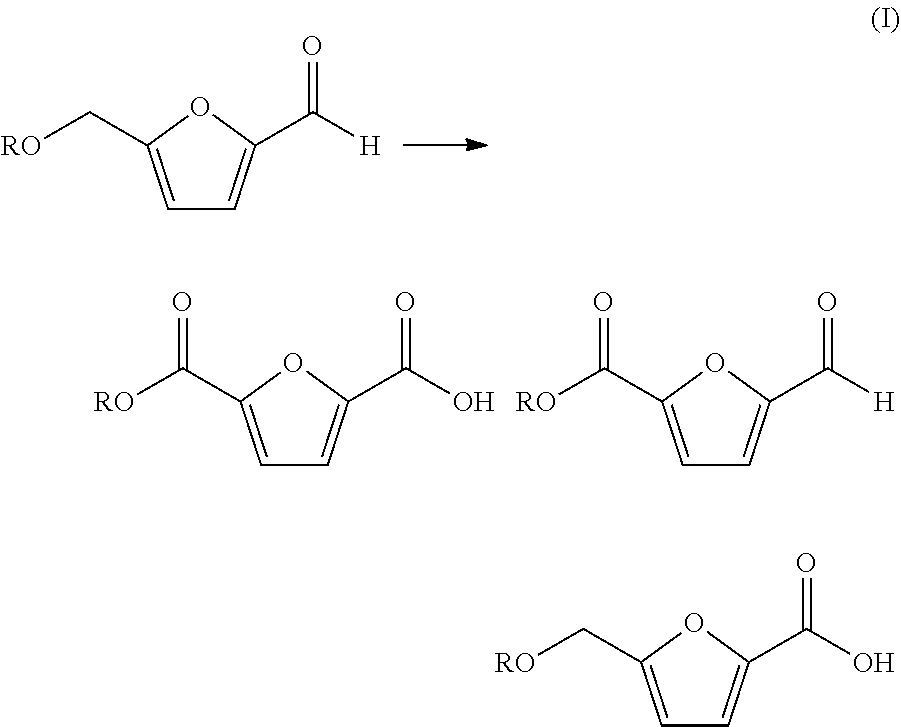Oxidation of furfural compounds
a technology of furfural compounds and oxidation methods, applied in the field of furfural compounds, can solve the problems of poor selectivity, low yield, unenvironmental friendly, etc., and achieve the effect of easy separation
- Summary
- Abstract
- Description
- Claims
- Application Information
AI Technical Summary
Benefits of technology
Problems solved by technology
Method used
Image
Examples
example 1
[0032]A reaction mixture containing 97% purity HMF (5.0 g), acetic acid (50 mL), cobalt acetate (0.97 g), manganese acetate (0.98 g), and methyl ethyl ketone (1.90 mL) was placed in a 100 mL reactor and subjected to 1000 psi oxygen at 120° C. for 3.5 hours. The sample was spotted on TLC plates (K5F Whatman) and developed in 1:1 EtOAc / hexane and visualized under UV light. Visual analysis indicated that after 3.5 hours, substantially all of the HMF was converted. The reaction mixture (58.58 g) was found to contain 46,356 g / kg DFF (86%), 2,908 g / kg FFCA (5%), 4,201 g / kg HMF (8%) and 62 g / kg FDCA (1%) for a DFF selectivity of 86%. Subsequent GC / MS data revealed the conversion of HMF to DFF m / z=124. Thus, after 3.5 hours, the conversion of HMF to DFF was essentially complete.
example 2
[0033]A reaction mixture containing 97% purity HMF (5.08 g), acetic acid (50 mL), cobalt acetate (0.973 g), manganese acetate (0.982 g), and methyl ethyl ketone (0.89 mL) was placed in a 100 mL reactor and subjected to 1000 psi oxygen at 120° C. for 4.5 hours. The reaction mixture (49.76 g) contained 41,368 mg / kg DFF (87%), 3,344 mg / kg FFCA, 2,671 mg / kg HMF and 32 mg / kg FDCA. Product selectivity of DFF was 87%. GC / MS data revealed complete conversion to DFF m / z=124. Acetic acid was removed and the product extracted with methyl isobutyl ketone. Substantially pure DFF (92% purity) was recovered.
example 3
[0034]A reaction mixture containing 97% purity HMF (10.04 g), acetic acid (50 mL), cobalt acetate (1.94 g), manganese acetate (1.94 g), and methyl ethyl ketone (1.78 mL) was placed in a 100 mL reactor and subjected to 1000 psi oxygen at 120° C. for 4 hours. Samples were taken at 2 and 4 hours and analyzed by LCMS.
TimeFDCAFFCAHMFDFF(h)(mg / kg)(mg / kg)(mg / kg)(mg / kg)23,9392,22114,72939,17941,0217,5447,72973,737
[0035]As is shown, after 4 hours, the reaction mixture (64.17 g) was found to contain 73,737 mg / kg DFF (82%), 7,544 mg / kg (8.3%) FFCA, 1,021 mg / kg FDCA (1.1%) and 7,729 mg / kg HMF (8.6%). GC / MS analysis revealed the essentially complete conversion to DFF with a parent ion at m / z=124.
Oxidation of HMF to FDCA
PUM
 Login to View More
Login to View More Abstract
Description
Claims
Application Information
 Login to View More
Login to View More - R&D
- Intellectual Property
- Life Sciences
- Materials
- Tech Scout
- Unparalleled Data Quality
- Higher Quality Content
- 60% Fewer Hallucinations
Browse by: Latest US Patents, China's latest patents, Technical Efficacy Thesaurus, Application Domain, Technology Topic, Popular Technical Reports.
© 2025 PatSnap. All rights reserved.Legal|Privacy policy|Modern Slavery Act Transparency Statement|Sitemap|About US| Contact US: help@patsnap.com



